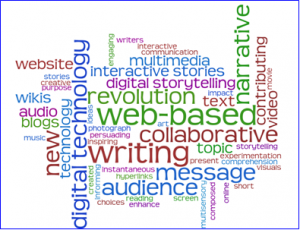It is fascinating to think about how social media impacts our world today. It is everywhere- we cannot escape it. The Internet has become our new encyclopedia, where we can acquire information on literally any topic that comes to mind. It is our generation that has witnessed digital media grow exponentially and rapidly become a significant part to our everyday lives. In particular, college students are using the Internet for practically everything. This is shown through students utilizing the Internet for current events, communicating with our peers, and college professors integrating web writing into their curriculum. Digital writing allows students to more flexible in their writing. It allows students to approach what they write as a learning process, not writing something for perfection.
So, how can digital writing in an academic setting be important?
It is quite common for students to say “I don’t want to go to class right now, I would rather be in bed”. I am guilty of saying this statement myself. I find this statement rather sad because college is an amazing period of our lives, and we should be eager to take advantage of all the wonderful opportunities college has to offer. A way to fix this predicament is to start integrating what students are passionate about into daily learning. Since, the Internet is so prevalent in student lives and typically a popular interest, I suggest that incorporating digital writing into academic settings is a way to heighten a student’s interest in class. To delve further into why this may be the case, I explored two chapters from the book Web Writing: Why & How Liberal Arts Teaching and Learning called “Tweet Me a Story” and “Sister Classrooms: Blogging across Disciplines and Campuses.” The two chapters convey how web writing is an integral part of the classroom and how it is useful to our academic world.
Before reading, “Tweet Me a Story”, I never considered Twitter as a source for completing academic work. I merely thought of it as a website where people follow celebrities, news reports, and post funny quotes. However, Leigh Wright believes that Twitter has the potential for much more. Leigh Wright uses Twitter to connect digital writing and social media to her classroom. She states that she has used Twitter to teach her students
“To write concisely, how to think quickly, and how to take the social media conversation, weave it with their own narration and craft a social media story on a digital platform”. (Tweet Me a Story).
Twitter enables her students to do this because it has a limit of 140 characters, which pushes them to write clear and concise messages. Though it is vitally important for college students to know how to write a well-articulated thesis, Leigh Wright has found numerous ways in which knowing how to “Tweet” well is also helpful in an academic setting. Wright had her students form a Twitter account for class purposes and followed her students’ tweets through the hastag “#Wright294”. Wright believed that having her students set up Twitter accounts was a fun and trendy way for her students to be engaged in both the classroom and social media. To get her students tweeting, she sent them out to a basketball game. Wright required her students to publish a minimum of twelve tweets by the end of the game. There, the students true colors and interests where revealed.
With a plethora of varying interests, Wright read a wide variety of different tweets from her students. For example, the sport enthusiast students tweeted about the game and the score, while other students who were not sports fans, would tweet humorous jokes about the way the fans cheered. They tweeted that the crowed sounded like they were chanting “leggo” instead of “lets go”. Students also showed their different interests through tweeting about the different outfits game watchers were wearing. Live Tweeting at the basketball game was a great way for students to practice writing clearly and concisely for an academic environment, while being actively engaged in social media. It was a way for students to express themselves. Wright explains that they made for more of a diverse and colorful class twitter feed.
It is clear that Twitter enhanced Wright’s students and pushed them to be more creative. She shows that Twitter is an excellent way for student’s to interact with each other and provide feedback. This is also shown through her Twitter scriptwriting assignment, where they were provided with a scenario and students had to tweet back and forth developing the story. Throughout the scriptwriting assignment, students were constantly interacting with each other and developing their imaginations.
Students often feel very much restricted in essay writing. Twitter allows students to get over that feeling. For me personally, I too feel restricted while essay writing. Being engaged with social media definitely relieves that feeling and allows me to be more creative.

Image taken from
Kate Combs
http://www.katemccombs.com/panda-memes-as-relationship-communication-tools/
In addition to Leigh Wright using Twitter in her classroom, Mary Knudson, a graduate professor at Johns Hopkins University, also requires her students to use Twitter in her class. In Knudson’s medical writing class, she requires her students to Tweet about a scientific conference. She states “Not only does Twitter teach students to write concisely with its strict limit on the length of posts, she said, but it also enables them to share valuable information”. Notably, Knudson was not always the biggest fan of social media, for she thought it destroyed student’s ability to spell. But as she started experimenting with Twitter, Knudson quickly realized all of its benefits. She uses it as a “writing tool- encouraging students to write concisely and in a way that’s engaging enough to retain readers”. This means that it encourages students to engage in dialog, share ideas, ask questions, and provide feedback.

http://finishlineonline.com/social-media/social-media/attachment/6-creative-social-media-campaigns-to-learn-from/
How are blogs powerful teaching tools?
Web Writing: Why & How Liberal Arts Teaching and Learning’s chapter “Sister Classrooms: Blogging across Disciplines and Campuses”, is so relevant to the importance of digital writing in an academic setting. Authors Amanda Hagood & Carmel Price describe this as “course blog can create a uniquely powerful learning community that invites students to learn through writing, rather than using writing as a means to prove mastery”. Writing digitally allows students to gain and provide feedback, therefore coming up with new ideas and modify and expand on what they are currently writing. Through this digital writing process, students are able to learn from one another as a whole and teach one another. Hagood and Price describe this process as “In performing each of these functions, students can begin collectively to teach one another new concepts without having to take on the authoritative role of the expert”. This enables students to learn from their peers, instead of solely from the professor. It also pushes students to think about what they write, from a different perspective, for they are constantly learning throughout the entire writing process.
Hagood and Price are big supporters of digital writing. They explain that writing digitally allows students more time to write, reflect, and articulate what they are posting online. They argue that the extra time writing digitally provides to students, enables them to write well rounded responses and push them to take more “high sophisticated risks”. They even argue that digital writing teaches students that writing well is rewarding. A well-written blog or eloquent comment on a blog post can even spark a class discussion, which in turn helps an entire class, learn as a whole. Overall, together throughout this process, students are continuously learning and building their writing skills.
Why does digital writing matter in education?
To explore this question, I read “Why Digital Writing Matters in Education” by Jeff Gabrill. Jeff Gabrill highlights two compelling reasons as to why digital writing matters in education.
- Digital writing challenges what counts as writing and reveals the gap between how writing works in the world and how we teach it in schools.
2 Digital writing platforms and services are ways to innovate instruction and learning.
Overall, writing has always been important, whether it is done in the classroom or not. It is a skill that is essential to have no matter your job. Due to all of the computer networks students are writing more than ever. Gabrill argues that since technology has developed significantly over the years, digital writing has become more “networked” and even “deeply collaborative or coordinated”. He gives the example of Wikipedia, and states that a website like “Wikipedia” would not be possible without a computer network. He also talks about “Facebook”, which is one of the largest collaborative writing platforms in history. Collaboration is significant because it allows for new ideas to come about, critiques to be made, and information to be spread.
Additionally, with everlasting digital technologies being developed, it has made writing in different fashions extremely easy, for we can use different modes of writing, videos, and images. Digital writing is also becoming more important because it is important to success in life. Well-developed digital writing skills have the ability to help people earn jobs and promotions. I completely agree with Gabrill’s arguments. Digital writing adds something new and exciting to classrooms and sparks interest amongst students. It provides students with many platforms in which they can do research. Most importantly, digital writing allows students to see how writing works in the real world.
Be smart about what you post. Be aware of the dangers. This will help you be more successful
With digital writing increasingly becoming incorporated into academic, work, and social settings it is vital that we are cognizant of what we post online. Jen Rajchel’s, Consider the Audience, provides an excellent argument for being cognizant of what we post online. Everything we post to the Internet is public, even if we privatize something, anyone can see it. So, it is important to be careful of what we post and comment. To bring in another factor, Rajchel notes that blogs have an increased possibility of plagiarism. Rajchel pushes her audience to consider questions such as:
- Think about how someone from your internship might read this?
- How might that differ from your professor?
- Will you be sending this to family and friends?
- A potential employer? A scholar whose work you cite?
…. Before posting a blog or anything to the Internet. Rajchel’s arguments are helpful to incorporating digital writing into not only a classroom, but also life in general. The arguments bring to light helpful hints of what to consider before posting something. Through doing this, I would argue that it leads to a better and more successful digital writing. It leads to a more successful writing because it helps students become more thoughtful and knowledgeable while writing digitally.
A link students may find helpful in digital writing, is called
A link students may find helpful in digital writing “10 Commandments of Twitter for Academics”. It is extremely helpful because it provides guidelines for appropriate posts.
What do I think about digital writing?
I believe digital writing has a lot to offer the classroom. It fosters engagement among students, creativity, thoughtfulness, and consistency. Currently, for a project in my English class, we are working on individual blogs. We are allowed to pick our own topic, which is amazing because it enables to write about something we are passionate about. For me personally, I am writing about running. It’s really exciting to blog about running because it allows me to share my passion for running with our online community. In addition, it allows me to learn and be in conversation with my peers in class, since we all subscribed to each other’s blog. This process has helped me learn and rearticulate my ideas. I am more creative because blogging enables to write about many different topics. For example, I blog recaps from my meets and blog about why running is special to me. Blogging also enables me to comment on other students writing, and push me to write in a more sophisticated manner. Our class blog supports me as a student at Dickinson College, because it is constantly encouraging me to become a better student and writer.
I believe, my blog for class, is highly relatable to the arguments posed by “Tweet Me a Story” and “Sister Classrooms: Blogging across Disciplines and Campuses”. Though I am not using twitter, I am still pushed to write concisely. Through reading other blogs and writing my own blogs, it is important to write concisely rather than dancing around the topic. Even if your blog is written in an alternative format- through a series of comics etc, it is important to have a main idea behind your blog. My blog for class also takes strongly to “Tweet Me a Story” and “Sister Campuses” because I am learning from my classmates, and don’t feel as restricted in what I am writing. My blog is encouraging me to be better writer. It encourages me to be a better writer, because I am getting feedback from my peers, seeing what my peers are writing, and constantly getting to revise my blogs. This is because digital writing allows me to be more flexible in my writing, so I am constantly able to learn throughout the entire writing process.
Digital writing has also pushed me to discover new interests. Since, starting a blog and reading numerous articles on digital writing in the classroom, I have been considering applying for internships in advertising, such as working for a magazine. I am interested in utilizing social media to promote products for companies. Going forward in my job search, though intimidating, I feel more confident in knowledge and abilities in digital writing. Dickinson’s magnificent liberal arts education has enabled me to explore the world of digital writing and push me to better writer for it. The digital writing I am doing at Dickinson, and in particular English 212, will ultimately be helpful for potential advertising jobs, because I would have prior experience in the digital writing world. Most importantly, I recognize the importance of digital writing cultivates- creativity, flexibility, consistency, and thoughtfulness. Overall, digital writing has been a learning process- a process that will follow me wherever I go, no matter the class or the job.
Works Cited
Kinzie, Susan. “Some Professors Losing Their Twitter Jitters.” The Washington Post 2009: Academic OneFile. Web. 29 Oct 2015.
Gabrill, Jeff. “Why Digital Writing Matters in Education.” Edutopia. George Lucas Educational Foundation, 11 June 2012. Web. 29 Oct. 2015.
Rajchel, Jen. “Consider the Audience.” Web Writing: Why and How for Liberal Arts Teaching and Learning (2013). Web. 29 Oct. 2015.
Gulliver, Katrina. “10 Commandments of Twitter for Academics.” The Chronicle of Higher Education. The Chronicle of Higher Education, 09 May 2012. Web. 29 Oct 2015. <http://chronicle.com/article/10-Commandments-of-Twitter-for/131813/>.
Hagood, Amanda, and Carmel Price. “Sister Classrooms: Blogging Across Disciplines and Campuses.” Web Writing: Why and How for Liberal Arts Teaching and Learning. Michigan Publishing, 15 Sep 2013. Web. 29 Oct 2015. <http://webwriting.trincoll.edu/communities/hagood-price-2013/>.
Wright, Leigh. “Tweet Me a Story .” Web Writing: Why and How for Liberal Arts Teaching and Learning. Michigan Publishing, 15 Sepember 2013. Web. 29 Oct 2015. <http://webwriting.trincoll.edu/engagement/wright-2013/>.



